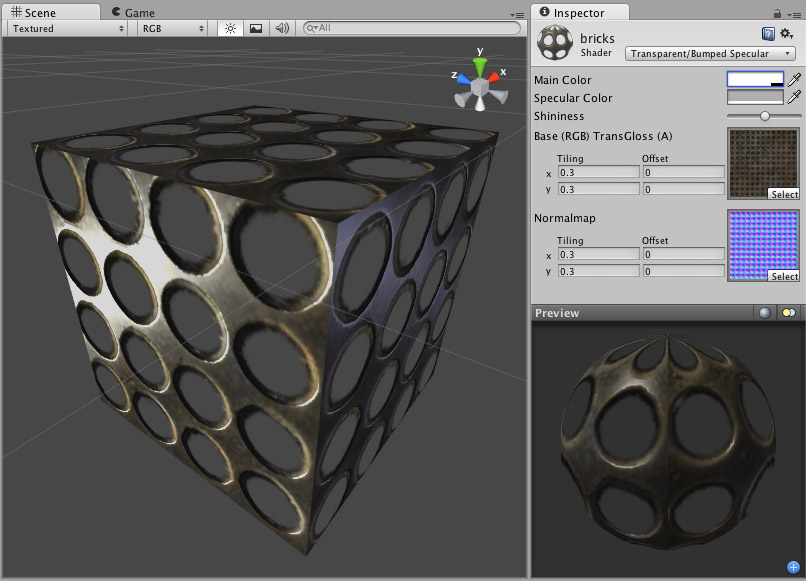透明凹凸镜面反射 (Transparent Bumped Specular)
注意:Unity 5 引入了标准着色器来取代此着色器。

此着色器的一个注意事项是基础纹理的 Alpha 通道同时定义透明区域以及镜面贴图。
Transparent Properties
注意:Unity 5 引入了标准着色器来取代此着色器。
This shader can make mesh geometry partially or fully transparent by reading the alpha channel of the main texture. In the alpha, 0 (black) is completely transparent while 255 (white) is completely opaque. If your main texture does not have an alpha channel, the object will appear completely opaque.
Using transparent objects in your game can be tricky, as there are traditional graphical programming problems that can present sorting issues in your game. For example, if you see odd results when looking through two windows at once, you’re experiencing the classical problem with using transparency. The general rule is to be aware that there are some cases in which one transparent object may be drawn in front of another in an unusual way, especially if the objects are intersecting, enclose each other or are of very different sizes. For this reason, you should use transparent objects if you need them, and try not to let them become excessive. You should also make your designer(s) aware that such sorting problems can occur, and have them prepare to change some design to work around these issues.
Normal Mapped Properties
Like a Diffuse shader, this computes a simple (Lambertian) lighting model. The lighting on the surface decreases as the angle between it and the light decreases. The lighting depends only on the angle, and does not change as the camera moves or rotates around.
Normal mapping simulates small surface details using a texture, instead of spending more polygons to actually carve out details. It does not actually change the shape of the object, but uses a special texture called a Normal Map to achieve this effect. In the normal map, each pixel’s color value represents the angle of the surface normal. Then by using this value instead of the one from geometry, lighting is computed. The normal map effectively overrides the mesh’s geometry when calculating lighting of the object.
Creating Normal maps
You can import normal maps created outside of Unity, or you can import a regular grayscale image and convert it to a Normal Map from within Unity. (This page refers to a legacy shader which has been superseded by the Standard Shader, but you can learn more about how to use Normal Maps in the Standard Shader)
Technical Details
The Normal Map is a tangent space type of normal map. Tangent space is the space that “follows the surface” of the model geometry. In this space, Z always points away from the surface. Tangent space Normal Maps are a bit more expensive than the other “object space” type Normal Maps, but have some advantages:
- It’s possible to use them on deforming models - the bumps will remain on the deforming surface and will just work.
- It’s possible to reuse parts of the normal map on different areas of a model; or use them on different models.
Specular Properties
Specular computes the same simple (Lambertian) lighting as Diffuse, plus a viewer dependent specular highlight. This is called the Blinn-Phong lighting model. It has a specular highlight that is dependent on surface angle, light angle, and viewing angle. The highlight is actually just a realtime-suitable way to simulate blurred reflection of the light source. The level of blur for the highlight is controlled with the Shininess slider in the Inspector.
Additionally, the alpha channel of the main texture acts as a Specular Map (sometimes called “gloss map”), defining which areas of the object are more reflective than others. Black areas of the alpha will be zero specular reflection, while white areas will be full specular reflection. This is very useful when you want different areas of your object to reflect different levels of specularity. For example, something like rusty metal would use low specularity, while polished metal would use high specularity. Lipstick has higher specularity than skin, and skin has higher specularity than cotton clothes. A well-made Specular Map can make a huge difference in impressing the player.
性能
通常,此着色器的渲染成本属于中等。有关更多详细信息,请查看着色器性能页面。